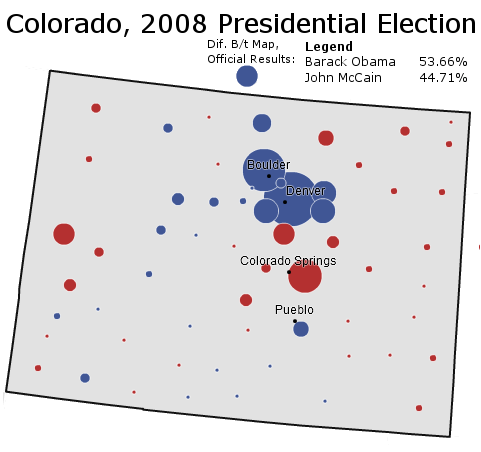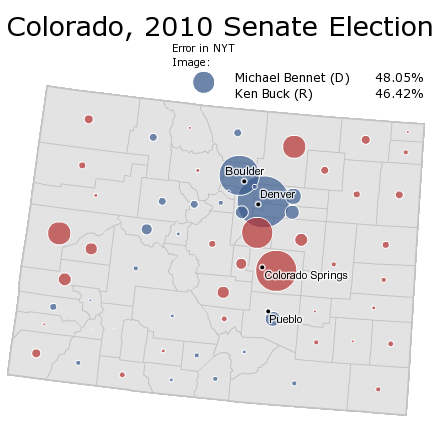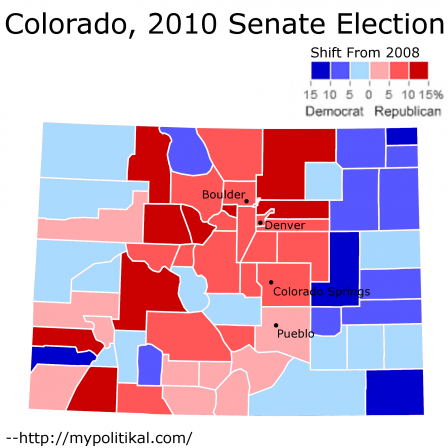This is a part of a series of posts analyzing the 2010 midterm elections. This post will analyze the Colorado Senate election, one of the few Democratic victories that night. In this election, Democrat Michael Bennett narrowly defeated Republican Ken Buck.
Colorado’s Senate Election
The results of the Colorado Senate election, like many other elections throughout 2010, closely matched the results of President Barack Obama’s 2008 presidential election. In fact, this senate election may have followed Mr. Obama’s performance more closely than any other election in 2010:
Only one county switched hands from 2008 to 2010: rural Chaffee County, which Senator Bennet won by a mere 44 votes.
More below.
This indicates that Colorado is a fairly polarized state. Its Republican parts go heavily Republican; its Democratic parts go heavily Democratic. Democratic candidate Michael Bennett did a full 7.3 percentage points worse than Mr. Obama, yet didn’t lose a single county that Mr. Obama won.
Notice too that both Mr. Bennett and Mr. Obama carve out a “C” of counties that they win in the middle of the state. When Democrats are able to do this, they generally win. When Republicans make inroads into the “C,” Republicans generally win. Republican candidate Ken Buck failed to make the necessary inroads into this territory, which is why he lost.
The Suburbs
Why did Mr. Bennett do so much worse than Mr. Obama?
Let’s take a look at Mr. Obama’s coalition first:
(Note: Because the Times stopped updating before all absentee/provisional ballots were counted, this map does not fully reflect the actual results. I have corrected the discrepancy.)
In 2008, Mr. Obama won Colorado by 9.0%. Interestingly, Colorado was the most important swing state that year. If Mr. Obama had lost all the states he did worse in than Colorado, he would have still won the election. But if he had lost all those states and Colorado, Senator John McCain would be president.
As this map shows, the Democrats get their votes from Boulder and Denver. Republicans get their votes from Colorado Springs and the rural areas. Take a particular look at the smaller blue circles around Denver. These are Denver’s suburbs, swing territory which Mr. Obama does quite well in. Also note the smaller red circle to the upper-left of Colorado Springs (Douglas County). Although it doesn’t look like it in this map, Douglas County is a Republican stronghold. Mr. Obama does remarkably well there, which is why the Republican margin of victory is so small.
Now let’s move to the 2010 Senate election:
(Note: Because the Times stopped updating before all absentee/provisional ballots were counted, this map does not fully reflect the actual results. I have corrected the discrepancy.)
In 2010 Mr. Bennett does a bit worse than Mr. Obama in the Denver suburbs; his margins are much smaller. Republican Ken Buck also is able to win Douglas County by a more normal margin for a Republican. The reason why Mr. Bennett does worse than Mr. Obama is mainly because of his weaker performance in the Denver suburbs.
Crucially, however, Democratic candidate Michael Bennett still wins the suburbs. Had he lost them, Colorado would today have a Republican senator.
Rural Colorado
A very interesting fact is revealed if one compares the shift of Colorado from 2008 to 2010:
This map illustrates that shift. Red counties became more Republican from 2008 to 2010; blue counties became more Democratic. This does not necessarily mean that a county which shifted Republican voted for the Republican (or vice versa). For instance, Denver shifted Republican from 2008 to 2010, but it still voted strongly Democratic in both elections.
Curiously, Democratic candidate Michael Bennett did better than Mr. Obama in a lot of Colorado’s most Republican areas. He improved substantially in the sparsely populated, strongly Republican rural counties – in particular the eastern part of the state. Mr. Bennett was involved in education in Denver before the election, so he has no local connection to rural Colorado.
There are several possibilities on why this happened. It seems that in presidential elections Republican areas vote more strongly Republican, and vice versa for Democratic areas. The map above could have been due to Republican and Democratic strongholds being less partisan during mid-term elections.
Another possibility is that the third-party vote had something to do with it. Neither candidate in 2010 was able to reach 50% of the vote, meaning that the third-party vote was relatively strong. If a third-party candidate takes a significant share of the vote, then mathematically Democrat margins will decrease in Democratic areas, and Republican margins will decrease in Republican areas.
Then there is the hypothesis that the president was a bad fit for rural Republican Colorado. He might have therefore have done worse than the average Democrat. Intuitively this explanation makes sense; Mr. Obama is not the type of person who appeals to rural Republicans.
Conclusions
One always must be careful to say that a particular state is trending for one party or the other. Nevertheless, the result of the 2010 senate election does seem to indicate that Colorado is moving Democratic.
2010 was the worst year in a generation for Democrats; Democrats throughout the country lost elections. In Colorado, a state that Bill Clinton lost in 1996, one would have expected Republican candidate Ken Buck to win.
Mr. Buck was admittedly a weaker-than-average candidate; he made some mistakes on abortion and the 17th Amendment. Yet, on the other hand, Mr. Buck was relatively untainted by scandal. He wasn’t obviously crazy, and he didn’t do extremely idiotic things. In addition, the Democratic candidate Michael Bennett wasn’t a very exciting candidate. He doesn’t inspire passion amongst Democrats; most people still have no idea who he is.
Yet Mr. Buck didn’t win – he lost to an unexciting Democratic in the best Republican year in a generation. Republicans should have won the suburbs around Denver in 2010; they were doing so everywhere else in the country. The fact that they failed to do so is a very powerful indicator of Colorado’s Democratic trend.
–inoljt




6 comments